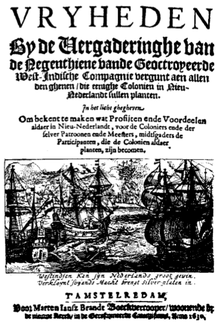Charter of Freedoms and Exemptions
| Charter of Freedoms and Exemptions | |
|---|---|

First page of the Charter of Freedoms and Exemptions
|
|
| Ratified | June 7, 1629 |
| Location | Netherlands |
| Author(s) | Dutch West India Company |
| Purpose | Establish patroonships in New Netherland |
The Charter of Freedoms and Exemptions, sometimes referred to as the Charter of Privileges and Exemptions, is a document written by the Dutch West India Company in an effort to settle its colony of New Netherland in North America through the establishment of feudal patroonships purchased and supplied by members of the West India Company. Its 31 articles establish ground rules and expectations of the patroons and inhabitants of the new colonies. It was ratified by the Dutch States-General on June 7, 1629.
The economic situation of the colony of New Netherland in the late 1620s could be considered a fairly good showing for a colony only newly started in a wilderness. The first settlement was built in 1613, strictly out of necessity, but soon after, forts were built. At the time of the charter, the oldest settlement was only 16 years old. But this slow success was hardly sufficient to create much excitement among the directors of the West India Company. The principal objective of this organization was to go after the spoils of war, which promised rich harvests in the captured fleets of the Spanish, with colonization being only a secondary consideration. Noting that the capture of the silver fleet in 1628 left the company proceeds of $115,000,000, and that the next year sundry privateers brought in a bounty of over $18,000,000, it was hardly surprising that so little attention was paid to the settlements in the Hudson River Valley. Those were "get rich quick" days for large corporations, and the slow and tedious procedure of colonizing and cultivating new countries found little favor in the eyes of the men at the helm.
The realization that greater inducements had to be offered to increase the development of the colony led the West India Company to the creation of the so-called "patroon system". In 1629, the West India Company issued its charter of "Freedoms and Exemptions" by which it was declared that any member of the Company who could bring to and settle 50 persons over the age of 15 in New Netherland, should receive a liberal grant of land to hold as patroon, or lord, with the exception, per , of the island of Manhattan. This land could have a frontage of 16 miles (26 km) if on one side of a river, or 8 miles (13 km) if situated on both sides. The patroon would be chief magistrate on his land, but disputes of more than 50 guilders could be appealed to the Director and his Council in New Amsterdam.
...
Wikipedia
